Son Doong Cave, home to towering stalagmites, underground rivers, and even a hidden jungle teeming with exotic wildlife, offers a once-in-a-lifetime chance to experience nature’s wonders up close. Discover how to visit the world’s largest cave and what incredible sights await you inside.
Son Doong Cave, the largest cave in the world, is an underground masterpiece that holds not just one, but three world records, making it a truly majestic and awe-inspiring natural treasure. This geological wonder is located in Quang Binh Province, Vietnam, and has been recognized by UNESCO as a World Heritage Site, further adding to its allure and global significance.
Join us as we uncover the mysteries of this extraordinary cave and explore the wonders that have made it one of the most remarkable places our planet has to offer!
1. Overview of Son Doong Cave
Son Doong Cave isn’t your average hole in the ground. It’s a colossal masterpiece hidden in Vietnam’s Quang Binh Province, part of the Phong Nha-Ke Bang National Park. Think of it as a secret kingdom where sunlight sneaks in to grow forests, where rivers roar underground, and where every corner holds a surprise. Discovered by chance and explored with awe, Son Doong Cave has become a legend for adventurers and dreamers alike. Let’s break it down piece by piece.

Son Doong is the world’s largest cave (Source: oxalisadventure)
1.1. Where is Son Doong Cave?
Tucked away in central Vietnam, Son Doong Cave lies within Phong Nha-Ke Bang National Park, a UNESCO World Heritage Site in Quang Binh Province. This park sprawls across 857 square kilometers of limestone peaks, tangled jungles, and over 400 caves, but Son Doong reigns supreme. It’s near the Laos border, about 50 kilometers northwest of Dong Hoi City. Surrounded by steep cliffs and thick greenery, reaching it feels like stepping off the map into a wild, untouched land.
1.2. How was Son Doong Cave in Vietnam Discovered?
Formation: Between 2 to 5 million years ago, river water flowed through a buried limestone area along a fault line, gradually eroding it into a massive underground tunnel. Eventually, parts of the cave ceiling collapsed, forming skylights and creating the vast dome of what we now know as Son Doong Cave.
Discovery: Son Doong was accidentally discovered in 1990 by Ho Khanh, a local man seeking shelter from the rain while trekking through the forest. However, his role in the cave’s discovery didn’t end there. When the British Cave Research Association (BCRA) arrived in Quang Binh in 2007, he reported his findings and joined them in the search. Though he couldn’t initially recall the exact location, he kept searching on his own. Finally, in 2009, he successfully led Howard and Deb Limbert of the BCRA to the cave’s entrance. By 2010, they confirmed it: Son Doong Cave in Vietnam was the world’s largest. A farmer’s hunch turned into a global sensation.
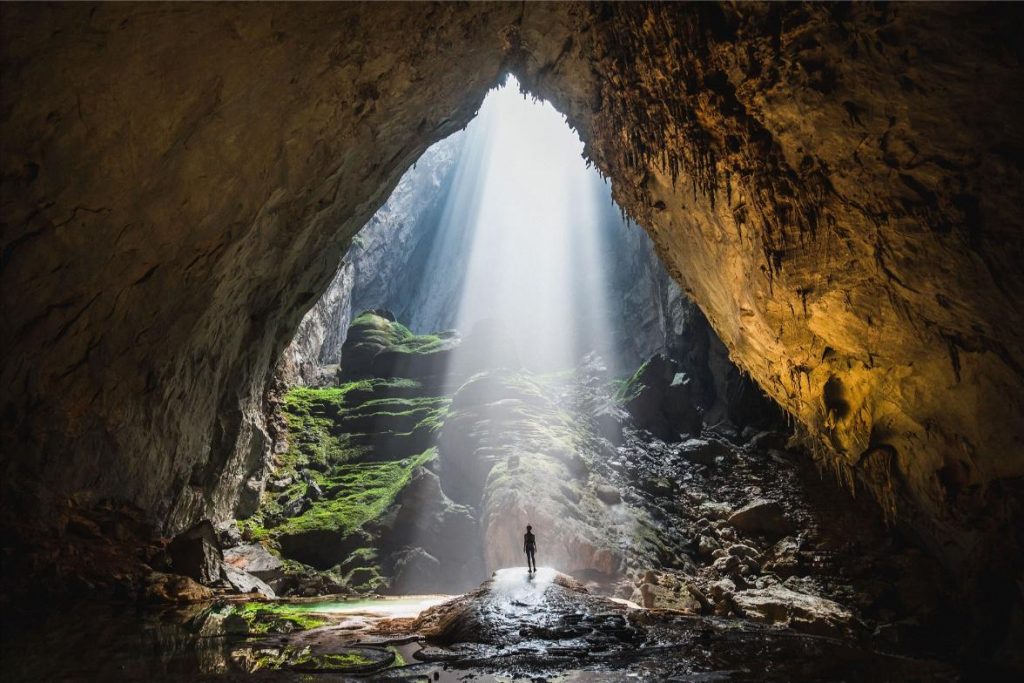
Son Doong Cave in Vietnam was discovered in 1990 and officially recognized as the world’s largest natural cave in 2009
1.3. How Big is Son Doong Cave?
Let’s talk numbers because Son Doong Cave is a giant. It stretches nearly 9 kilometers long, that’s 5.6 miles of twisting tunnels. At its tallest, it soars 200 meters high, enough to fit New York’s One Penn 1 skyscraper with room to spare. Its widest points span 150 meters across. Scientists estimate its volume at 38.5 million cubic meters, making it five times larger than Malaysia’s Deer Cave, the previous champ. Inside, you’ll find chambers so vast they could hold entire neighborhoods. Son Doong Cave redefines “big” in every way.
The enormity of Son Doong is further highlighted when comparing it to other notable caves in the vicinity. For example, En Cave, which is recognized as the third largest cave in the world, is a mere fraction of the size of Son Doong. Son Doong is around 5 times larger than En Cave and surpasses it in every dimension.
1.4. What Makes Son Doong Cave Unique
What truly makes Son Doong a worldwide wonder is its extraordinary interior universe. Within this massive cave system, distinct microclimates have emerged, creating varied environments where temperature, humidity, and light levels fluctuate dramatically from chamber to chamber. These diverse conditions have fostered specialized habitats where fascinating organisms have adapted to life in these unique niches.
The cave’s magnificent stalagmite and stalactite formations stand as natural monuments to time itself. These colossal structures, some towering 70-80 meters high, have been sculpted drop by drop over countless millennia as mineral-laden water slowly transformed into stone masterpieces that both captivate visitors and chronicle the cave’s ancient history.
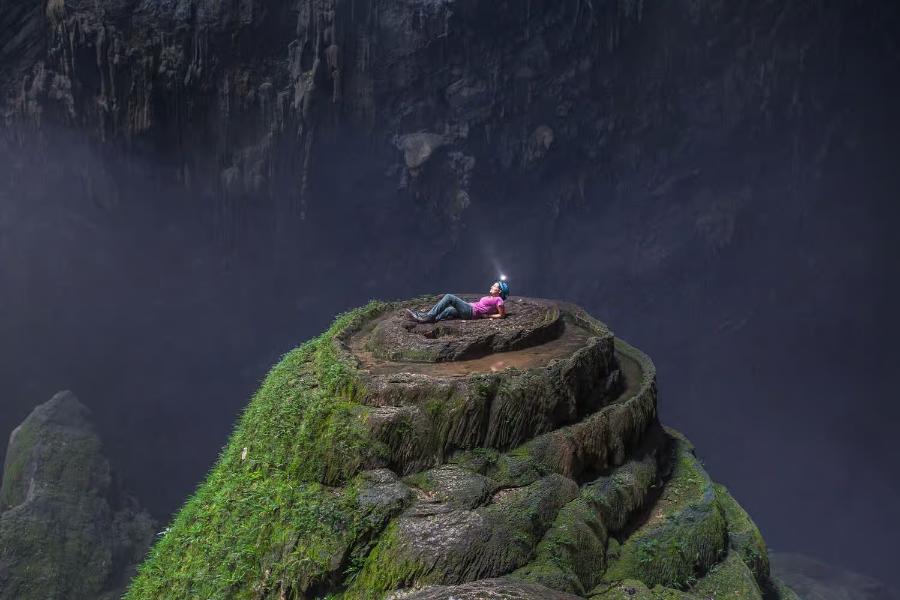
The “Wedding Cake” is one of the most iconic formations in Son Doong Cave (Source: oxalisadventure)
Perhaps most surprising is Son Doong’s remarkably rich ecosystem. Venturing through its vast passages, explorers encounter lush greenery thriving in seemingly impossible conditions. This vibrant tapestry of plant and animal life flourishing deep beneath the earth serves as a powerful reminder of nature’s incredible adaptability and persistence. Walking among these underground jungles and forests evokes a profound sense of wonder at life’s tenacity and the earth’s hidden marvels.
1.5. Son Doong Cave’s Incredible World Record Titles
on Doong Cave, located in Vietnam, boasts an extraordinary collection of global distinctions, cementing its reputation as a premier natural wonder:
Guinness World Records: On April 30, 2013, Guinness World Records officially designated Son Doong as the world’s largest cave.
World Record Association and World Records Union: Beyond Guinness, both the World Record Association and World Records Union also recognized Son Doong as the planet’s largest cave, amplifying its international prominence.
UNESCO World Heritage Site: The cave’s exceptional geological and ecological significance earned it a place within Phong Nha – Ke Bang National Park, inscribed as a UNESCO World Heritage Site in 2003, highlighting its global heritage value.
Son Doong has continued to capture worldwide attention through various prestigious accolades:
- 2014: The New York Times named Son Doong among the top 52 must-visit destinations globally.
- 2015: ABC’s Good Morning America aired live from the cave, bringing its splendor to viewers worldwide.
- 2015: National Geographic offered an immersive 360-degree photo tour of Son Doong’s vast chambers.
- 2019: DJ Alan Walker featured the cave in his widely viewed YouTube music video, Alone Pt. II.
- 2020: Business Insider included Son Doong in its list of the world’s top 20 natural wonders.
- April 14, 2022: Google honored Son Doong with a Doodle displayed on its homepage across 17 countries.
2. 5 Unmissable Natural Marvels to Explore in Son Doong Cave
2.1. The Hope and Vision Passage
The Hope and Vision Corridor, an awe-inspiring expanse within Son Doong Cave, stretches roughly 1.5 kilometers, its vast archway so immense it could accommodate a Boeing 747 passing through. This majestic passage unveils some of the cave’s most breathtaking features, with two geological marvels stealing the spotlight. The first, known as the “Hand of Dog,” is a colossal stalagmite soaring to an impressive 60 meters, resembling a sentinel carved by time. The second is the planet’s tallest stalagmite, a monumental formation towering at approximately 80 meters, standing as a testament to nature’s unparalleled artistry.
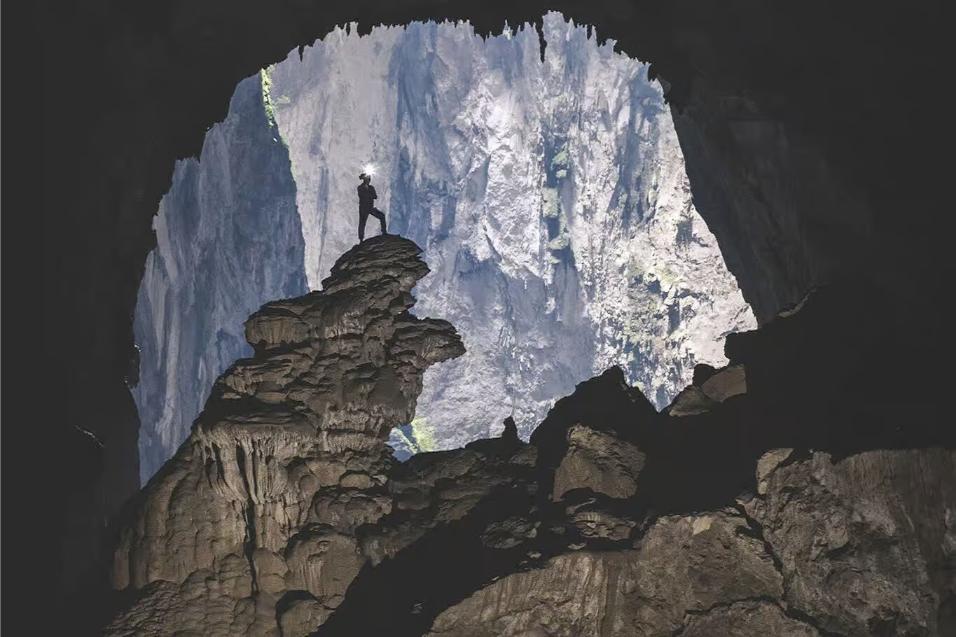
The “Hand of Dog” is a notable rock formation inside Son Doong Cave in Vietnam (Source: oxalisadventure)
Bathed in an interplay of shadow and ethereal light filtering through distant openings, the Hope and Vision Corridor captures the sublime grandeur of Son Doong. Its scale and splendor evoke a sense of wonder, revealing the raw, untouched beauty of one of Earth’s most extraordinary subterranean realms. This passage not only showcases the cave’s geological significance but also invites explorers to witness nature’s ability to craft masterpieces over millennia.
2.2. The underground river
Another remarkable feature of this cave is the mysterious underground river, formed by the convergence of water from two neighboring caves: En Cave and Khe Ry Cave. To reach the area known as the “Hope and Vision Passage,” visitors must actually cross this subterranean river.
Silently weaving its way through the depths of the cave, the river creates an intricate system of underground waterways that remains only partially explored. Along its journey, the water flows over cascades, rocky slopes, and stunning formations sculpted by nature over millions of years. Strangely, the river disappears at a point roughly 4.5 kilometers from the cave entrance, leaving behind unanswered questions and enduring mysteries. To this day, its true source and full extent are still being investigated by explorers and scientists.
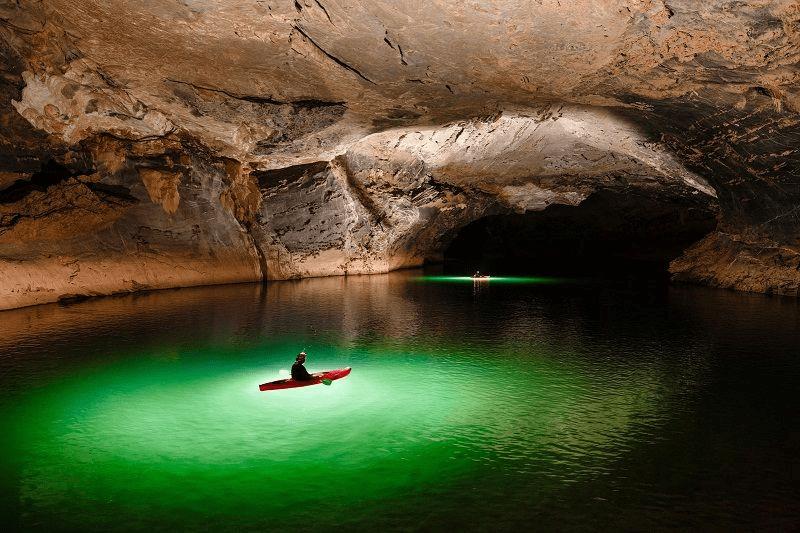
The underground river inside Son Doong Cave in Vietnam
2.3. The sinkholes
Son Doong Cave is home to two remarkable sinkholes that are among its most impressive features. These are called Doline 1 and Doline 2.
Doline 1, also known as “Watch Out for Dinosaurs”, was formed when part of the cave ceiling collapsed. This created a large opening that connects the cave to the outside world. The skylight rises about 450 meters from the cave floor. On sunny days from January to March, sunlight streams through the opening and shines deep into the cave. This creates a beautiful natural light show that brightens the dark space and leaves a lasting impression on visitors.
Doline 2, called the “Garden of Edam”, is located about one kilometer away from Doline 1. Inside this sinkhole, a dense and ancient jungle has formed about 200 meters below the surface. Thanks to the sunlight that comes through the opening and the moisture that seeps in through the cave’s limestone walls, this area has developed its own unique climate. It supports a rich variety of plants that grow deep underground.
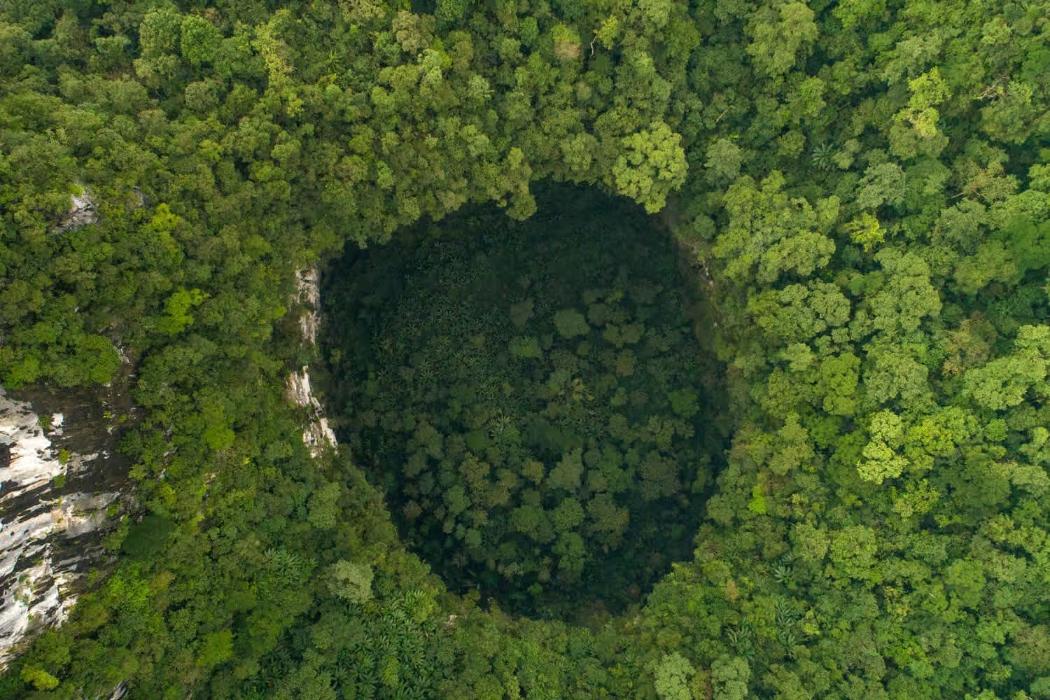
Doline 2 viewed from above (Source: oxalisadventure)
These two sinkholes are not only beautiful to look at, but they also help create a special environment inside the cave. Many visitors are amazed by their beauty and enjoy taking photos of these rare natural wonders.
2.4. The Natural “Great Wall” of Vietnam
One of the most impressive sights inside Son Doong Cave is a giant wall of calcite called the “Great Wall of Vietnam.” This is the tallest calcite flowstone in the cave, rising to nearly 100 meters. It looks like a huge natural fortress and continues to amaze anyone who sees it.
When this wall was first found, it was a big challenge to climb. The British Vietnam Caving Expedition team needed two full days to get to the top. They used drills, anchors, and special climbing skills to make their way up. Two experienced cavers, Gareth Sewell (also known as Sweeny) and Howard Clarke (also known as Clarkey), were the first people to reach the top and explore what was on the other side.
Today, visitors can climb this wall with the help of equipment. There is a stainless steel ladder that is 18 meters tall placed at the lowest part of the wall. After that, safety ropes help people climb the next 65 meters. Even with this support, the climb is still steep and high, so it can be difficult for those who are afraid of heights or not used to adventure activities.
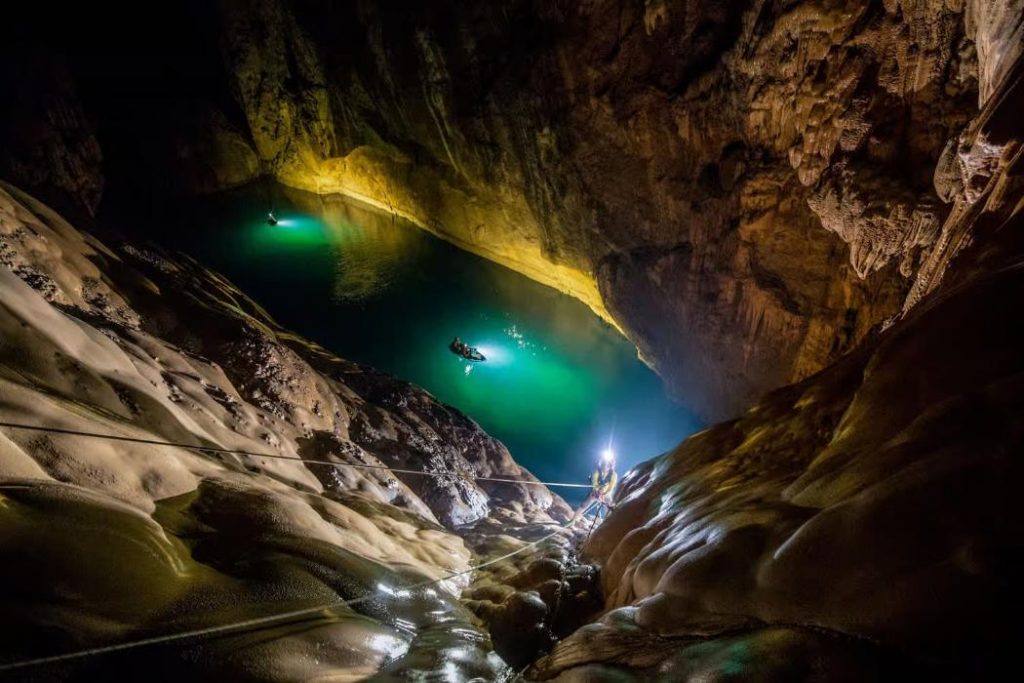
The “Vietnam Wall” inside Son Doong Cave (Source: oxalisadventure)
However, reaching the top brings a special feeling of success and wonder. It is not only the way out of the cave but also a moment that many people remember as the highlight of their journey.
2.5. The Wondrous Cave Pearls
One of the special sights inside Son Doong Cave is the cave pearls. These are small, round stones with smooth and shiny surfaces. They are formed over a long period of time when water drops from the ceiling and carries calcium. As the water drips onto the cave floor, it leaves behind thin layers of calcium around a small grain of sand or another tiny object. Slowly, these layers build up and form what we call cave pearls.
The pearls come in different sizes. Some are as small as peas, while others can be quite large. They shine softly under the cave’s dim light, looking like natural gems scattered on the ground.
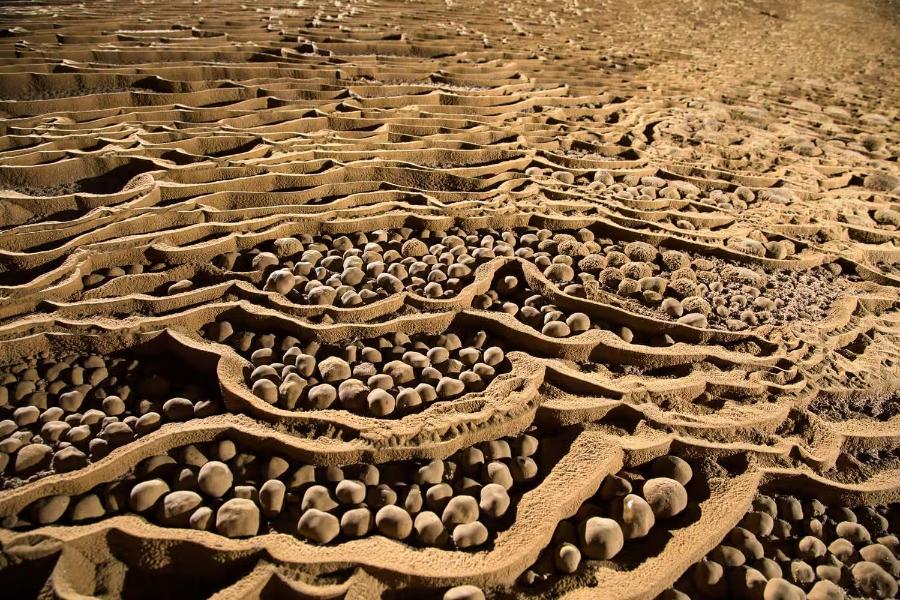
The interesting special pearl-like formations in Son Doong Cave (Source: oxalisadventure)
To help protect them, visitors are not allowed to touch the cave pearls. However, you are welcome to look at them closely and take photos. Seeing these beautiful formations adds even more wonder to your journey through the world’s largest cave.
3. What to see and do in Son Doong Cave, Quang Binh
3.1. Camping in one of the world’s most beautiful caves
The two campsites inside Son Doong Cave in Quang Binh are undoubtedly among the most beautiful and unique camping spots in the world. Both are located near the edges of the sinkholes, allowing you to gaze up at the starry sky on clear nights.
At these campsites, visitors are given clear instructions on camp regulations, which helps minimize any impact on the cave’s delicate environment.
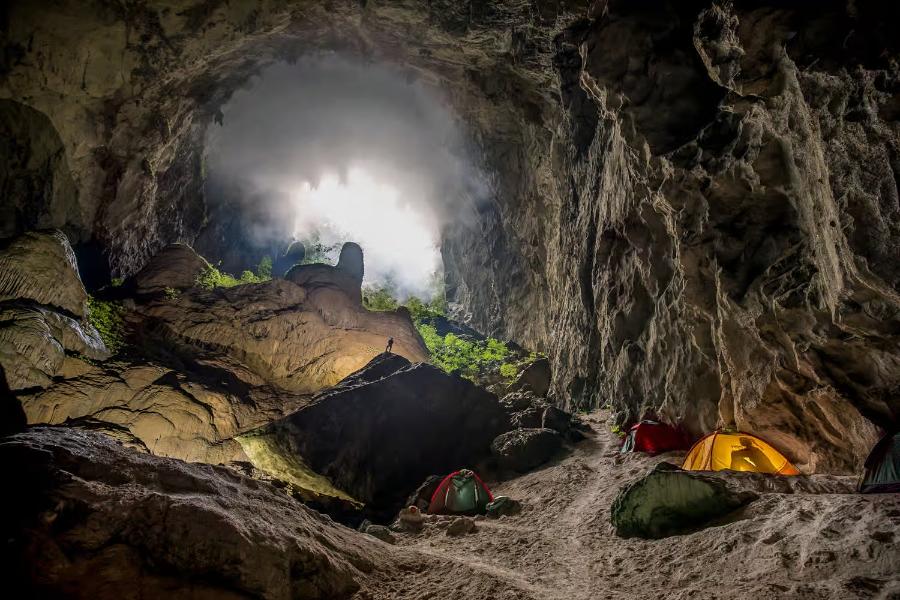
The campsite 2 scene at Sinkhole 2 in Son Doong Cave, facing toward the Garden of Eden (Source: oxalisadventure)
3.2. Swimming in the cave’s hidden lakes and rivers
Swimming in Son Doong Cave is an unforgettable experience. As you immerse yourself in the cool, crystal-clear underground river, surrounded by towering rock walls and a peaceful atmosphere, it feels as though you’ve entered another world.
Light filtering through high openings above reflects off the water, creating a magical, shimmering scene, like swimming in a fairy tale. The only sound is the soft echo of water flowing through the cave, offering a sense of tranquility and relaxation.
However, it’s important to follow the guide’s instructions here. In certain areas, the current can be very strong, making swimming potentially dangerous.
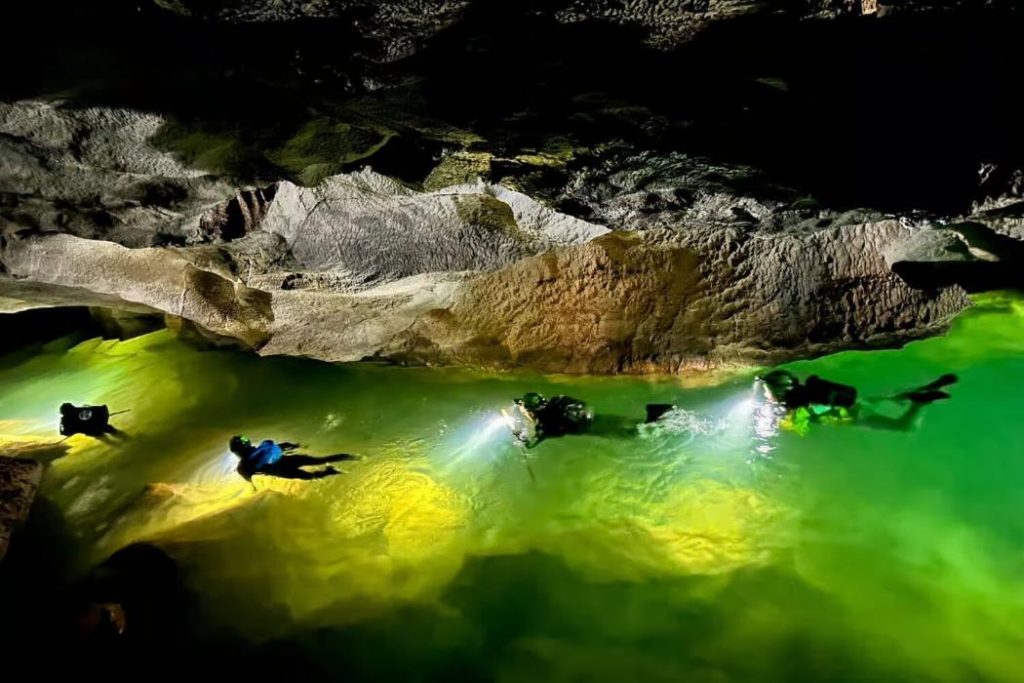
Swimming inside Dai Cao Cave, part of the Son Doong Cave system
3.3. Capture Stunning Photos in a One-of-a-Kind Landscape
Son Doong Cave is not only a natural wonder but also one of the most photogenic places on Earth. With its towering rock formations, lush underground jungle, and dramatic light streaming through giant sinkholes, it offers the perfect setting for breathtaking photos.
You can take incredible shots in front of massive calcite towers or capture the magical moment when sunlight hits the mist rising from the cave floor. Even if you’re not into taking selfies, the cave itself is full of amazing scenes worth photographing — from glowing green plants to surreal rock textures shaped over millions of years.
4. Visiting Son Doong for the First Time? Here’s What to Know
4.1. How to get to Son Doong Cave?
Start your journey in Dong Hoi City, the closest big town in Quang Binh Province. From there, it’s a short drive to Phong Nha town, where your adventure begins. You can fly to Dong Hoi from Hanoi or Ho Chi Minh City, or take a train or bus. The only way into Son Doong Cave is with Oxalis Adventure, the official tour company. It’s a two-day hike through the jungle to reach the entrance, so be prepared to walk.
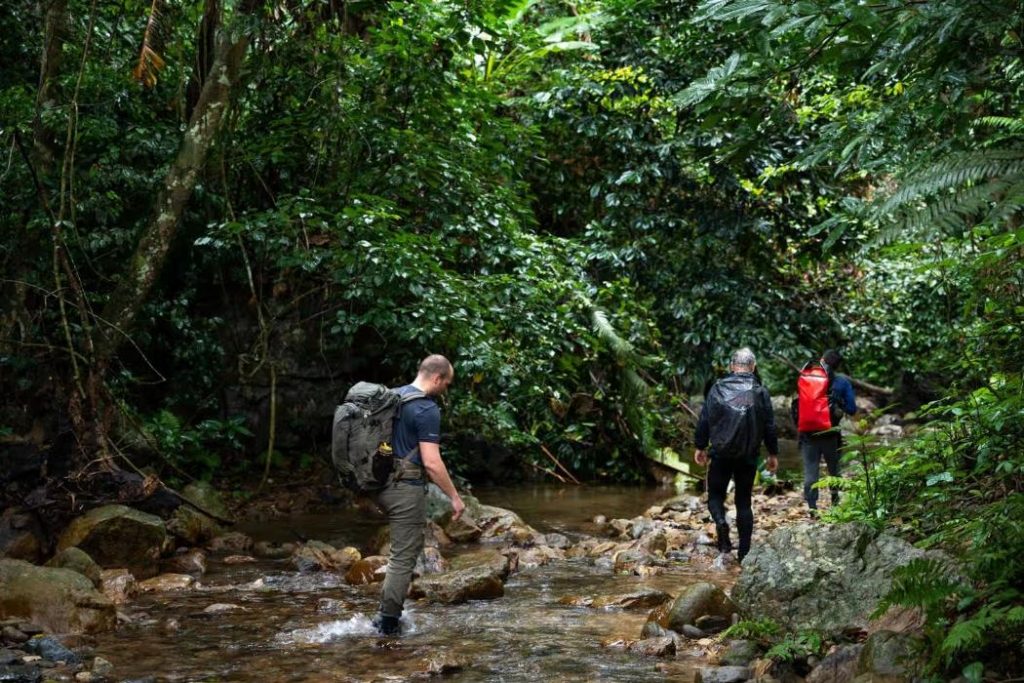
On the way to Son Doong Cave in Vietnam (Source: oxalisadventure)
4.2. Best Time to Explore Son Doong Cave
Son Doong Cave welcomes visitors from January to August, offering different experiences depending on the time of year:
- January to March brings cooler weather, but without heavy fog, making it a great time for clear views and photography inside the cave’s massive chambers.
- April to May is ideal for trekking, as the changing seasons bring mild sunlight and little rain. Trails are dry and more comfortable to navigate.
- June to August is the hottest period, but the cave’s cool underground streams offer a perfect way to refresh after a long trek. If you don’t mind the heat, this season adds a unique thrill to the adventure.
No matter when you go, Son Doong promises unforgettable scenery and a once-in-a-lifetime journey underground.
4.3. All You Need to Know About the Son Doong Cave Tour
Oxalis Adventure is currently the only travel company authorized to operate tours to Son Doong Cave. Each tour lasts 5 days and 4 nights and costs just over 73,000,000 VND, making it one of the most premium tours in Vietnam.
While the price may seem high, the experience is truly one-of-a-kind — something you’ll remember for the rest of your life. The tour price includes everything: technical experts, tour guides, a safety support team, accommodation, meals, and necessary gear.
Tours are available from January to August, but spots are limited each year, so it’s important to book early if you want a chance to visit.
Keep in mind that this is a physically demanding trek. You’ll need to cross rivers, climb over rocky terrain, and hike for hours each day. A good level of fitness is required, and unfortunately, people with certain health conditions may not be able to join. Participants must also be 18 years or older.
Below is a basic map for reference:
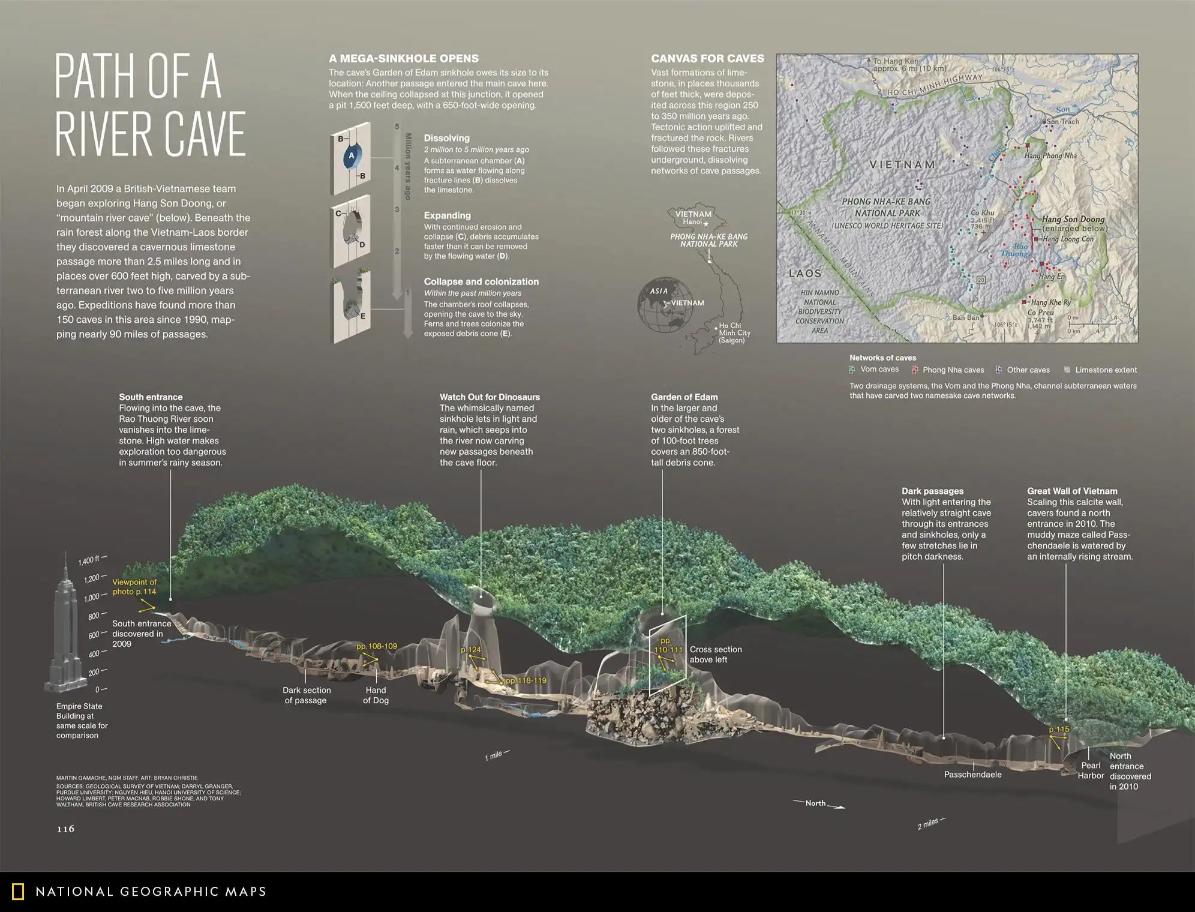
A map of Son Doong Cave in Vietnam (Source: Collected)
Besides exploring the world’s largest cave, the tour also includes visits to Doong Village and Hang En, which was featured in the movie Peter Pan.
4.4. Useful Tips for Visiting Son Doong Cave in Quang Binh
To make sure you have a safe and enjoyable journey inside the world’s largest cave, here are some simple things you should bring with you:
- Trekking clothes: Wear light and quick-drying clothes. Long-sleeved shirts and long pants are best to protect your skin from scratches, bugs, and plants along the trail. Avoid clothes that are too thin or loose.
- Trekking shoes and socks: Choose sturdy trekking shoes with good grip and quick drainage. You’ll be walking through water and uneven ground, so comfort and safety are key. Your socks should be long, breathable, and thick enough to avoid blisters. Bring 4 to 5 pairs in case they get wet.
- Backpack for trekking: Oxalis will provide you with a helmet and headlamp, and you’ll need a backpack to carry them, along with other small personal items like water, snacks, or a jacket.
- Clothes for camping: At the campsite, you’ll want something comfortable to wear. Shorts and t-shirts are good for warmer months, while from December to March, you should pack long pants, long sleeves, and a light jacket to stay warm in the cooler nights.
- Other camping essentials: Don’t forget to bring sunscreen, sunglasses, a hat, towel, and foot powder to stay fresh and dry. Since there are no showers at the campsites, it’s helpful to pack wet wipes and dry shampoo for personal care.
Being well-prepared will help you enjoy your Son Doong adventure to the fullest!
Son Doong Cave, the world’s largest, is a jaw-dropping wonder that feels like stepping into a hidden realm. Picture yourself surrounded by towering rock formations and shimmering underground rivers, soaking in the sights and echoes of this magical place. Why wait? Put Son Doong Cave on your travel list and experience nature’s stunning beauty for yourself!
During your visit to Vietnam, don’t hesitate to reach out to Lux Travel DMC for inspiring journeys that connect you with nature, culture, and local people — all tailored to your wishes with a 100% satisfaction guarantee!
